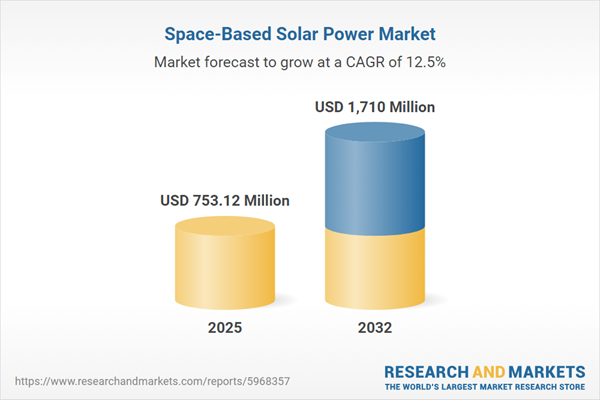Speak directly to the analyst to clarify any post sales queries you may have.
Space-based solar power is becoming a strategic solution for organizations aiming to secure reliable, sustainable energy and support operational growth. Senior decision-makers are increasingly evaluating innovative energy alternatives that can enhance business resilience, align with regulatory expectations, and drive long-term value.
Market Snapshot: Global Space-Based Solar Power Market Overview
The global space-based solar power market stands at USD 669.26 million in 2024, with a projected compound annual growth rate (CAGR) of 12.49%. By 2025, the market will reach USD 753.12 million and may expand to USD 1.71 billion by 2032. This current and anticipated growth is supported by ongoing developments in space-grade photovoltaic technology, evolving satellite deployment methods, and progressive regulatory measures. Strategic collaborations between the public and private sectors are lowering market entry barriers and expanding industry participation across established and emerging organizations.
Scope & Segmentation: Space-Based Solar Power Market
This comprehensive report provides detailed insights tailored for executive decision-makers seeking to optimize resource allocation, adapt to shifting policy environments, and reinforce long-term strategic planning in the space-based solar power sector. Segmentation analysis allows leaders to refine investment and operational strategies along the market's value chain while accounting for unique opportunities, risks, and timelines.
- Orbit Types: Geostationary, low earth, and medium earth orbits allow distinct system architectures, supporting specific mission needs and diverse energy transmission models.
- End User Industries: Commercial operators, government agencies, defense entities, telecommunications providers, and utilities rely on space-based solar power to strengthen energy reliability, sustain mission-critical activities, and diversify supply models.
- Application Areas: Solutions support agricultural output, facilitate enhanced Earth observation, enable real-time communications, and provide emergency power to isolated or off-grid locations, ensuring organizational continuity.
- Technology Types: Hybrid solutions, including both flexible and rigid photovoltaic arrays and solar dynamic systems, address requirements for scalability and adaptability in rapidly changing operational settings.
- Power Capacity Segments: Options ranging from early pilot deployments to large-scale installations provide tailored pathways for organizations at different readiness levels, supporting steady growth and future scalability.
- Regional Coverage: Americas, Europe, Middle East & Africa, and Asia-Pacific regions exhibit diverse adoption rates and regulatory factors, which influence priorities for forming partnerships and determining optimal investment timing.
- Leading Companies: Major participants such as Lockheed Martin Corporation, The Boeing Company, Northrop Grumman Corporation, Airbus SE, Raytheon Technologies Corporation, China Aerospace Science and Technology Corporation, Mitsubishi Heavy Industries, Thales Alenia Space SAS, Solaren Corporation, and Surrey Satellite Technology Limited are shaping technological direction, setting competitive standards, and enabling cross-border collaboration.
Key Takeaways for Strategic Planning
- Phased satellite launches provide organizations with adaptable financial controls, aligning capital allocation to stages of technological implementation and project progression.
- Public and private stakeholder partnerships are advancing regulatory approval, integrating emerging technologies, and accelerating delivery timelines for new infrastructure projects.
- Careful orbit selection fosters operational efficiency, allowing organizations to align power transmission with fluctuating energy usage patterns across different industries and regions.
- Deploying systems in difficult or remote areas extends connectivity, secures vital assets, and supports uninterrupted service under unpredictable circumstances.
- Utilizing AI-driven monitoring and predictive maintenance tools boosts asset reliability and optimizes operations, empowering executive teams to streamline oversight and reduce manual processes.
2025 United States Tariff Impact: Evolving Procurement Strategies
Recent adjustments to U.S. tariffs affecting photovoltaic films and semiconductor components are having a broad impact on sector supply chains. Organizations are turning to local sourcing strategies to manage potential supply risks and ensure project continuity, while domestic providers are adapting to meet evolving regulatory requirements. These procurement adjustments safeguard project settlement schedules and support ongoing system reliability for energy initiatives.
Methodology & Data Sources
This analysis brings together insights from experts in satellite engineering, infrastructure management, and regulatory policy, supplemented by peer-reviewed technical studies and leading industry publications. The multi-disciplinary approach delivers robust, actionable intelligence for senior leaders in the space-based solar power market.
Why This Report Matters
- Enables executives to implement renewable energy solutions, cultivate strategic partnerships, and proactively manage risks within the evolving value chain.
- Provides frameworks for technology selection and market entry strategies that withstand changes in both regulatory and industry landscapes.
- Empowers organizations with scenario planning tools, equipping leadership to strengthen market resilience and confidently address operational priorities.
Conclusion
With focused sector analysis and timely monitoring of emerging trends, this report equips senior decision-makers to design flexible, forward-looking strategies for success in the dynamic space-based solar power marketplace.
Additional Product Information:
- Purchase of this report includes 1 year online access with quarterly updates.
- This report can be updated on request. Please contact our Customer Experience team using the Ask a Question widget on our website.
Table of Contents
3. Executive Summary
4. Market Overview
7. Cumulative Impact of Artificial Intelligence 2025
Companies Mentioned
The companies profiled in this Space-Based Solar Power market report include:- Lockheed Martin Corporation
- The Boeing Company
- Northrop Grumman Corporation
- Airbus SE
- Raytheon Technologies Corporation
- China Aerospace Science and Technology Corporation
- Mitsubishi Heavy Industries, Ltd.
- Thales Alenia Space SAS
- Solaren Corporation
- Surrey Satellite Technology Limited
Table Information
| Report Attribute | Details |
|---|---|
| No. of Pages | 186 |
| Published | October 2025 |
| Forecast Period | 2025 - 2032 |
| Estimated Market Value ( USD | $ 753.12 Million |
| Forecasted Market Value ( USD | $ 1710 Million |
| Compound Annual Growth Rate | 12.4% |
| Regions Covered | Global |
| No. of Companies Mentioned | 11 |








